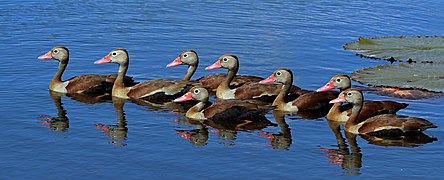Portal:Trinidad and Tobago
Trinidad and Tobago Portal
The Republic of Trinidad and Tobago is a country located at the southern tip of the Caribbean. It borders the countries of Grenada and Venezuela. It was the first Caribbean country to host the Summit of the Americas. It shares maritime boundaries with other nations including Barbados to the northeast, Guyana to the southeast, and Venezuela to the south and west. A treaty between the Republic of Trinidad and Tobago and the Republic of Venezuela on the delimitation of marine and submarine areas, 18 April 1990. The country covers an area of 5,128 square kilometres (1,980 sq mi) and consists of two eponymous main islands, Trinidad and Tobago, and numerous smaller landforms. Trinidad is the larger and more populous of the main islands; Tobago is much smaller, comprising about 6% of the total area and 4% of the entire population which is estimated at 1.3 million (2005). The nation lies outside the hurricane belt. Unlike most of the English-speaking Caribbean, Trinidad and Tobago's economy is primarily industrial with an emphasis on petroleum and petrochemicals. Trinidad and Tobago is well known for its African and Indian cultures, reflected in its large and famous Carnival, Diwali, and Hosay celebrations, as well being the birthplace of steelpan, the limbo, and music styles such as calypso, soca, rapso, parang, chutney, and chutney soca.[1][2][3][4][5][6][7] Selected article - The history of Tobago covers a period from the earliest human settlements on the island of Tobago in the Archaic period, through its current status as a part of the Republic of Trinidad and Tobago. Originally settled by indigenous people, the island was subject to Spanish slave raids in the sixteenth and early seventeenth century and colonisation attempts by the Dutch, British, French, and Courlanders beginning in 1628, though most colonies failed due to indigenous resistance. After 1763 Tobago was converted to a plantation economy by British settlers and enslaved Africans. Tobago came under French control in 1781 during the Anglo-French War, returned to British control in 1793 during the War of the First Coalition, but was returned to France in 1802. The island was recaptured by the British in 1803, and remained under their control until independence in 1962. (Full article...)CategoriesSelected quoteIn the news
WikiProject
General imagesThe following are images from various Trinidad and Tobago-related articles on Wikipedia. Selected picture Blooming Yellow Poui trees dot in the Northern Range of Trinidad.
Did you know
Selected cuisine
The House of Angostura (English: /æŋɡəˈstjʊərə/), also known as Angostura Limited, is a Trinidad and Tobago company famous for the production of Angostura bitters, invented by the company's founder. The company is also a distiller and is the major producer of rum in Trinidad and Tobago. The company also has been used as a vehicle for international expansion by its parent company, CL Financial. As a result of these acquisitions, the company owns distillers in the United States, Canada, The Bahamas and Suriname. The company was founded around 1830 in the Venezuelan town of Angostura (now Ciudad Bolívar) by a German doctor, Johann Gottlieb Benjamin Siegert, Surgeon-General in Simon Bolivar's army in Venezuela. Around 1820, he had tried to find a medicine to improve appetite and digestive well-being of the soldiers. From the beginning Dr. Siegert was determined to wrest a cure from nature itself, and after four years of trial and error, researching and analysing the qualities of tropical herbs and plants, he finally arrived at a unique blend of herbs in 1824, which he called "Amargo Aromatico" or aromatic bitters. [...] Dr. Siegert hoped to use the bitters to bring relief to his patients, his small circle of family and friends, but these events were to prove otherwise. From these humble beginnings an international industry was soon to rise.
Selected panoramaTopicsLists
Select [►] to view subcategories
Recognized content
Featured articlesFeatured listsGood articles
Did you know? articles
Featured pictures
Featured portalsIn the News articles
Main page featured articlesMain page featured listsPicture of the day pictures
Related portalsWikiProjectsTrinidad and Tobago Wikipedians' Notice Board · Trinidad and Tobago Wikipedians
On this dayOn this day for the Trinidad and TobagoAssociated WikimediaThe following Wikimedia Foundation sister projects provide more on this subject:
Portal informationThis portal has been maintained by WikiProject Trinidad and Tobago
Discover Wikipedia using portals |
||||||||||||||
- ^ "In Trinidad, Diwali Lights Up Like Christmas". NPR. Archived from the original on 17 February 2020. Retrieved 20 March 2019.
- ^ "Diwali in Trinidad and Tobago". trinidad.us. Archived from the original on 2 March 2019. Retrieved 20 March 2019.
- ^ Ingram, Amy. "What is Chutney Music?". Wesleyan University. Archived from the original on 16 July 2011. Retrieved 10 September 2018.
- ^ "Parang Music". Destination Trinidad and Tobago. Archived from the original on 10 September 2018. Retrieved 10 September 2018.
- ^ "Soca Music History". Artdrum. Archived from the original on 19 September 2018. Retrieved 10 September 2018.
- ^ "A brief history of the steel pan". BBC. 24 July 2012.
- ^ "Trinidad Carnival for Beginners". Caribbean Beat. 1 January 1993. Archived from the original on 8 April 2018. Retrieved 10 September 2018.































































